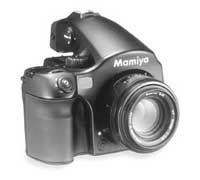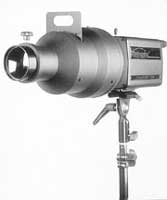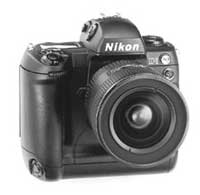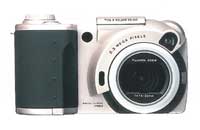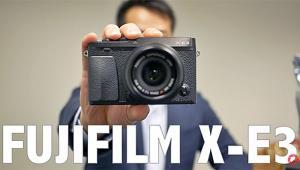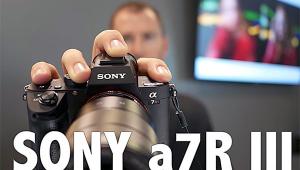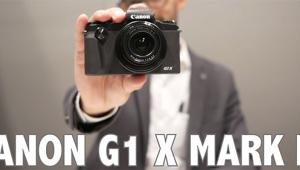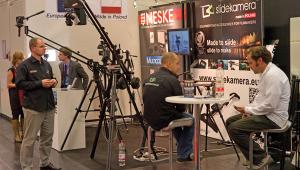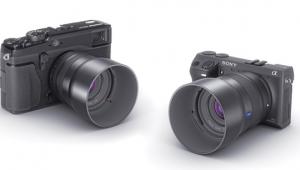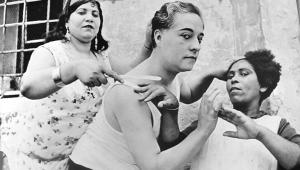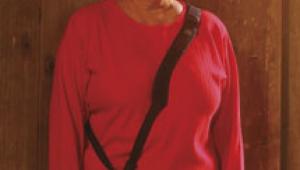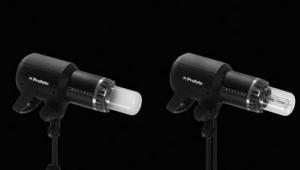Show Report
PhotoPlus Expo West '99
PhotoPlus Expo West '99
was held this past June 17-19 at the Los Angeles Convention Center,
which represents as centrally located a venue as possible for the far-flung
denizens of L.A.'s urban sprawl. |
|||
Comet (distributed in the US by Dyna-Lite) introduced their CX-244Tc power pack, which features an output of 2400 ws and digital touch panel controls. Three channels can be used with symmetrical or asymmetrical light distribution through one to four heads, and each channel is independently variable. Other specs include: controllable recycling rate; dual synch cord sockets; audible ready signal; proportional modeling light control; built-in slave. Comet also showed the new CAX-32H variable focus flash head. It is rated for 3200 ws and features a bare tube design. A wide range of light control accessories is available for it. Dyna-Lite has replaced their M800e power pack with a more powerful, yet smaller model, the M1000e. Providing a 1000 ws output, it weighs 6.6 lbs and measures 57/8x67/8x67/8", including the handle. The two channels can accommodate four heads, in symmetrical or asymmetrical configurations. Power is variable over a five stop range, and modeling lights can be controlled at the pack. The head cord sockets are arc protected. |
|||
Jobo was showing their recently introduced roller transport, tabletop Printlab processors, the most interesting of which is the top of the line Model 3504. It will accommodate paper up to a 12" width, which means 11x14" or 12" by whatever on 12" roll paper. It will dry to dry process RA-4, black and white, and Duratrans (drive speed is variable). Chemistry replenishment is automatic via infrared sensors, and the four 5 liter tanks feature airtight anti-oxidation lids. The unit doesn't require a tempered water supply; it has its own onboard heater, so only a cold water source is necessary, and there's no temperature monitoring required. Another neat feature is the built-in cleaning program; the processor automatically drains the working solutions into bottles for subsequent use, fills with water and runs the transport system, then drains the rinse water. A 230v power supply is required. The Model 3504 measures 38x24x17". |
|||
Mamiya was demoing their new 645AF, first brought to your attention by Bob Shell a few months ago. Expected on dealer's shelves in October, it should please a lot of Mamiya fans. A full test review will be forthcoming. This promises to be quite a versatile camera. |
|||
Norman has introduced a unique new monolight, the M1200-P. Its "something different" touch is that it's the first monolight that can power a second, auxiliary lamphead. Dual digital controls allow independent lamphead control over a six stop range in 1/10 stop increments, monitored on dual LED displays. The switchable auxiliary is especially convenient when it is boom mounted. There are three power ratio options: 1200 ws monolight, aux off; 800 ws monolight, 400 ws aux; 600 ws monolight, 600 ws aux. This innovative monolight should prove popular for location portraiture; it is built for rugged duty use and accepts more than 100 Norman accessories. The M1200-P (Portrait) accepts Norman Series 500 lampheads; a companion M1200-C (Commercial) model accepts Norman Series 900 lampheads. |
|||
NPC had their recently introduced Proback Polaroid proofing backs for the Canon EOS 3, Leica R8, and Nikon F100 on display. They have also brought back the Polaroid 195 camera, now dubbed the NPC 195. Many small format photographers have missed this camera, preferring the full 31/4x41/4" prints to the smaller image area of Polaroid backs for 35mm and medium format cameras. The original features have been retained: Copal No. 0 shutter, with manual shutter speed and aperture selection; 114mm lens; coupled range-finder; compact folding design; full flash synch at all speeds. The only change is the film chamber; NPC has adapted the latest Polaroid CB-103 pack film holder for improved processing reliability. |
|||
Photogenic announced their new PL47FS Focusing Snoot. This device fits onto any Photogenic Powerlight, allowing a photographer to project interesting patterns onto an otherwise static background. The snoot uses standard 31/2" Rosco patterns, with hundreds to choose from. The patterns can be combined with colored gels for even greater variety. Those ordering before December 1, 1999 will receive three free accessory lenses (66mm, 106mm, 123mm) for the snoot. Photogenic also introduced their CL1000 light, a fan cooled continuous ("hot") light in a rugged aluminum housing; it accepts 3200K lamps from 400-1200w. |
|||
THK had a couple of new high-performance
tele-converters from Kenko, the PRO 300 1.4x AF and PRO 300 2x AF. They
are designed to be used with telephoto lenses of 100mm or longer focal
length, and are best in the 200-500mm range. They can also be used with
telephoto zooms, but not those with a zoom range that starts under 50mm.
These multi-coated, five and seven element converters employ super-low
dispersion glass from Hoya, which matches prime lens optical quality,
even at the edges. The optical design and wide light path avoid vignetting
problems. Lens mounts and core are metal, to support today's heavy
lenses and camera bodies. They are available in Canon EOS and Nikon AF-D
mounts. There are a few Nikon AF-S/AF-I lenses that are not autofocus
compatible, as well as a couple of Canon EF macros; check with THK or
your dealer. |
|||
Digital Cameras At PhotoPlus Expo West '99 by David B. Brooks New Kodak Professional DCS 660 Digital Camera. This newly announced digital camera from Kodak provides the high-resolution 6Mp (megapixel) of the well established DCS 560, now for photographers who are Nikon based, integrating the latest Kodak DCS capabilities in an F5 camera body. The DCS 660 provides all of the features of portability, use in all kinds of light and varied conditions, with the widest subject application, providing the high-performance color response and digital image quality of the latest Kodak technology. The DCS 660 may be used with any light source with adjusted film speeds from ISO 80-200, to capture 36-bit color images. Image exposure may be checked for accuracy with the patented histogram using the large LCD display. Image storage is convenient and unlimited with two PCMCIA card slots for removable media. The DCS 660 may also be used as a tethered to a computer studio camera with its FireWire connector, now supported by the new Power Macintosh G3 computer with built-in IEEE 1394 connectors. Continuous long-term operation is assured by removable batteries which can be changed in the field with extra charged cells. The DCS 660 will be available in July 1999 and has a suggested list price of $29,995. |
|||
Nikon Professional
Digital SLR D1 Camera. The first thing to be seen approaching
the Nikon booth at PhotoPlus Los Angeles was a D1 camera banner. D1 designates
it's the new Nikon professional digital SLR camera. Sporting 2.74Mp
capture with a 23.7x15.6mm CCD (about 65 percent of a 24x36mm frame) it
provides a 1.5 lens focal length factor making viable use of existing
lens selections. Targeted to photojournalism, this Nikon digital SLR offers
the fastest, 4.5 fps burst rate for continuous shooting and an ultra short
0.05 sec shutter delay for responsive shooting of fast happening events.
Image storage is via Compact Flash Card and rapid downloads are assured
by a IEEE 1394 FireWire interface connector. Expected Nikon shooting control
is incorporated including 3D Matrix metering and Dynamic AF focus operation.
The D1 has the standard F-mount so the camera may utilize a selection
of 80 different Nikon optics. Handling of the lightweight magnesium SLR
body and its controls are consistent with the Nikon F5 and F100, although
the D1 is new from the ground up. |
|||
Fuji MX-2900 Zoom Digital
Camera. It has not been that long since Fuji dazzled the PMA
audience with their 2.3Mp, shirt pocket sized MX-2700. Now that that camera
has just gotten onto store shelves Fuji is announcing another 2.3Mp digital
camera, the MX-2900 Zoom. The MX-2700 is a cutely modern digital camera
appealing to the point-and-shoot crowd, while this new, slightly up-scale
model is a conventional camera configuration with a '30s retro style
and manual capabilities that will appeal to serious photographers. This
includes manual shutter and aperture control, selectable white balance
settings for different lighting conditions, exposure compensation, and
flash brightness adjustment. With its built-in pop-up flash there is a
Slow Synchro mode which allows balancing the flash with low levels of
ambient light. Metering is selectable between multi, which allows the
camera to balance exposure for background and subject, as well as spot
and average meter modes to select metering according to subject conditions. Manufacturers/Distributors Canon U.S.A., Inc. Dyna-Lite Flash Equipment (Comet) Eastman Kodak Fuji Photo Film U.S.A. Inc. Jobo Fototechnic, Inc. Mamiya America Corp. Nikon Inc. Norman Enterprises, Inc. NPC Corp. Photogenic THK Photo Products (Tokina) |
- Log in or register to post comments



